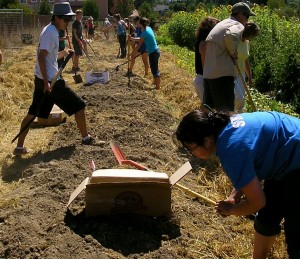Our Farm to Institution Committee hosted a Farm to School workshop at Santa Rosa City Schools last October. With over 70 food service staff and farmers in attendance the event was a huge success. I harvested kale and winter squash especially for some of the demonstration recipes, which were served for lunch. After a series of talks by leaders in the farm to school movement we had a productive farmer/buyer speed dating session, during which connections and deals were made with school food service. Next week we are hosting a second workshop, where we will hold a series of breakout groups on topics like food safety and distribution.

Our winter squash and new spicy kale being served to workshop participants. Notice that the winter squash is not peeled; when baked, the skin is soft enough to eat.
Over in West County, I’ve been working closely with Analy’s eco action class. The class came out last Fall to harvest corn and plant fava beans on our farm(Three Leaf Farms). The students made pizza for school lunch last winter with Three Leaf Farms produce. Just last week, the students came and harvested the fava beans they planted and we made fava bean hummus.
Since August I have been delivering between 60 and 200lbs of vegetables per week to Santa Rosa City Schools. These include kale, sweet peppers, radishes and squash. We now have written agreements to supply produce next school year.

Analy students making pizza with Three Leaf Farms peppers, squash and tomatoes. Zazu baker Casey (on the left) gave dough forming lessons.












